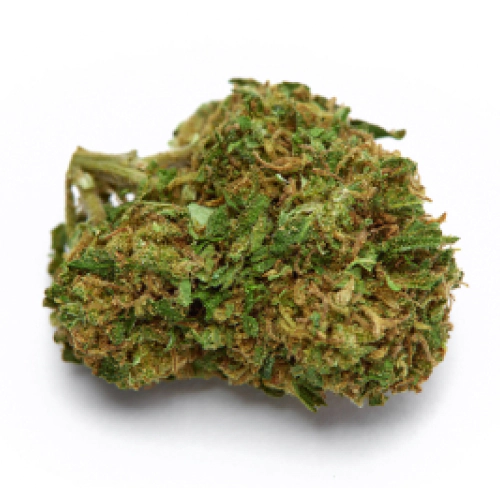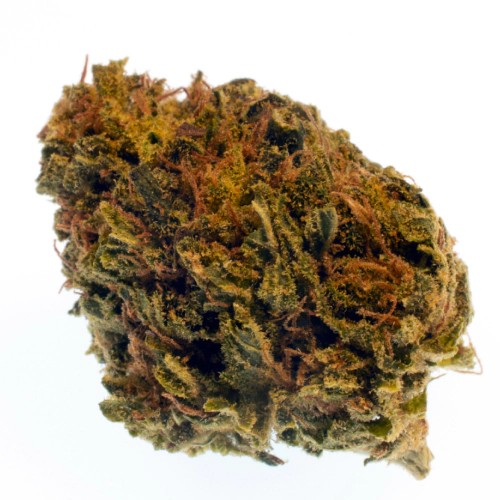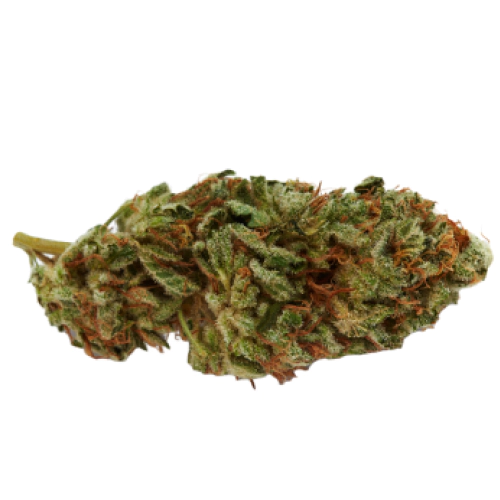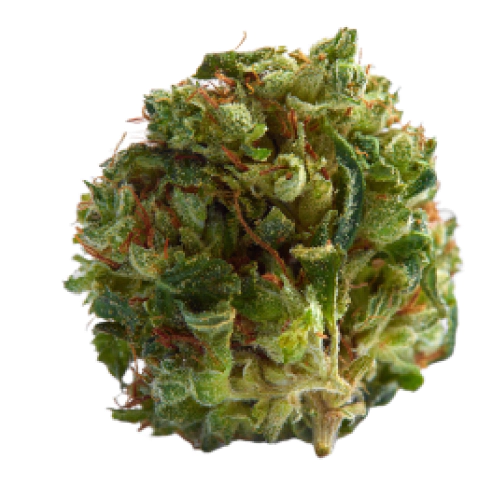THC 9 - 13.67%
CBD 0.29 - 0.57%
Effect Concentrated
Flavor Sweet
15.07 - 16.73%
0.54 - 0.92%
0.24 - 1.2%
Pungent, Pine
Sleepy
The Chemo strain (also known under the names of UBC Chemo and Kemo) is a legendary Indica-dominant hybrid with a medical focus. As its name implies, this marijuana strain was created to help cancer patients cope with adverse effects caused by chemotherapy.
Its THC percentage ranges between 15.07% and 16.73%. Also, the strain has gotten its popularity due to an impressive cannabinoid profile manifested by:
This weed can be smoked by people with any THC tolerance, though inexperienced users should be mindful of the dose to avoid overconsumption and heavy couch-locking effects.
This cannabis boasts a blend of pine and wood as basic aromas caused by limonene and camphene. Its taste may seem a little spicy, but this pungency is soothed by an earthy flavor, which is typical for caryophyllene.
The weed consumers enjoy a euphoric high with a nice cerebral lift. Full-body sedation and relaxation follow this elevated high and can induce a refreshing and deep sleep. The body reaches a peaceful state and becomes free from pain. It leaves smokers with mild tingling sensations and makes them feel happy. Some users can be hit with a powerful case of munchies since this kush acts as an appetite enhancer.
Known for its strong medicinal effects, the Chemo strain is a helping hand for people struggling with:
Chemo can also be used by recreational users to unwind after a stressful day.
The common negative reactions caused by cannabis use may include:
The strain is quite rare and available only as clones. It prefers a cool climate and requires an experienced hand to grow. The plants reach maturity and start blooming 60-67 days after germination. They look different from other strains due to their large and wide leaves, which is a distinctive feature. The plants grow 60’’-80’’ high in indoor environments and more than 90’’ in outdoor gardens. In optimal indoor conditions, they can be harvested in 73 days and are reported to produce medium-sized yields of 0.5-1 oz. per 1 ft2.
| THC | Tetrahydrocannabinol, or THC, is a major cannabis chemical compound. It is a psychoactive element that stimulates dopamine release and induces euphoria or happiness. THC-rich strains may be helpful with such conditions as lack of appetite, chronic pains , etc. It is considered to be the primary active marijuana component. | 15.07 - 16.73% |
| CBD | Cannabidiol, or CBD, is a major compound in cannabis, which is non-psychoactive. It is also proved to counteract the side effects of the second major component THC. CBD is widely used for medicinal purposes in rubs, oils and so on. It is helpful in muscle pain cases, may treat arthritis and migraines. Even Greeks used it against pain, while Queen Victoria applied it to get rid of menstrual cramps. | 0.54 - 0.92% |
| CBC | Cannabichromene, or CBC, is a minor cannabinoid, meaning that its quantity in cannabis is quite little. Though it has the same origin as CBD and THC, it is different in functions. Without any psychoactive effects, it is an efficient cannabis compound in combating acne and depression. CBC produces analgesic, antibacterial and anti-inflammatory effects. | 0.1 - 0.76% |
| CBG | Cannabigerol, or CBG, is one of the minor cannabis compounds in adult plants. On the other hand, young ones contain a lot of this antibacterial and anti-inflammatory component. During the growth, CBG is converted into different cannabinoids, mostly THC and CBD. The compound itself increases appetite and decreases eye pressure. | 0.24 - 1.2% |
| CBN | Cannabinol, or CBN, is a trace element in cannabis that is considered to be mildly psychoactive. It appears from oxidation THC, exposed to light and heat. CBN is mostly contained in old cannabis and in traditional hashish. It is effective against insomnia, bacterial infections and appetite loss. | 0.24 - 0.4% |
| THCV | Tetrahydrocannabivarin, or THC-V, is a compound contained in cannabis in trace amounts. Even though it is close to THC molecularly, it is different in effects. This compound may be psychoactive only in large amounts. THC-V reduces blood sugar, controls appetite, stimulates bone growth, etc. African Sativa strains are the richest in THC-V. | 0.16 - 0.98% |
| Pinene | Pinene is one of the most widespread terpenes in nature, found in pine trees, basil, nutmeg, parsley, and rosemary. Cannabis containing terpene (alpha-pinene or α-pinene) boasts a strong pine scent. Pinene is responsible for anti-inflammatory, pain-relieving, and anti-anxiety effects. | 0.06% |
| Myrcene | Myrcene (also known as β-myrcene) is one of the most common terpenes found in cannabis, representing more than 20% of the modern marijuana terpene profile. Myrcene has a distinct earthy, musky flavor, resembling cloves. It is responsible for calming and soothing effects of weed. Myrcene is also found in hops, thyme, mango, lemongrass, guava melon. | 0.11% |
| Ocimene | Ocimene (derived from the Ancient Greek word Ocimum meaning basil) is a terpene with sweet and herbaceous flavors, also boasting citrusy and woody undertones. Naturally, ocimene occurs in mint, parsley, orchids, hops, kumquats, mangoes, basil, bergamot, lavender, and pepper. Offers antifungal, anti-inflammatory, and antiviral properties. | 0.07% |
| Camphene | Camphene is terpene common for carrots, pepper, dill, fennel, nutmeg, thyme, as well as other fruits and vegetables. Camphene has a damp, pungent, herbal, minty aroma with pine undertones. In cannabis, mostly found in Indica strains. Camphene causes cooling sensations, having anti-inflammatory, antibiotic, antioxidant, analgesic, and antifungal effects. | 0.21% |
| Humulene | Humulene (also known as α-humulene) is one of the major terpenes found in cannabis, contributing to woody, earthy, spicy, herbaceous, and, mainly, floral aromas of cannabis. Used in modern medicine, humulene offers anti-inflammatory, antibacterial, and appetite suppressant effects, which have been well-researched by pharmaceutical companies. | 0.06% |
| Limonene | Limonene (also known as d-limonene) is the second most common terpene in nature and the third most common terpene in cannabis. It has a powerful citrus aroma and can be found in all citruses, including lemons, oranges, grapefruits, limes, juniper, etc. Limonene is known to elevate moods and provide anxiety, depression, and stress relief. | 0.15% |
| Linalool | Linalool (also known as beta linalool, linalyl alcohol, linaloyl oxide, and p-linalool) is one of the rarest terpenes found in cannabis, mostly in small quantities. Linalool is known for its spicy and lavender aroma, bringing relaxation and calming effects. It is also said to provide anti-inflammatory and analgesic properties that can be useful for athletes. | 0.04% |
| Terpinolene | Terpinolene is one of the most common terpenes found in cannabis; however, It's usually presented in small quantities. Is responsible for piney, floral, herbaceous, and even a little bit citrusy aroma of cannabis. Terpinolene can be found in lilacs, nutmeg, and cumin. In cannabis, terpinolene contributes to the sensation of "freshness." Has the potential to reduce the risk of heart diseases. | 0.07% |
| Phellandrene | Phellandrene (also known as alpha- and beta-phellandrene) is one of the rare terpenes found in cannabis with antihyperalgesic and antidepressive properties. Phellandrene contributes to a minty, woody, and mildly citrus aroma in cannabis. Previously confused with limonene and pinene, phellandrene was eventually distinguished as a separate terpene common for eucalyptus. Also, it could be found in mint, dill, black pepper, cinnamon, parsley, pine, and lavender. | 0.07% |
| Caryophyllene | Caryophyllene (also known as beta or b caryophyllene) is a terpene found in many herbs and spices, such as black pepper, basil, rosemary, and oregano. Cannabis high in caryophyllene delivers a strong spicy, peppery aroma, resembling cinnamon and cloves. Caryophyllene offers potent anti-inflammatory and sedative effects. | 0.17% |
| Total terpenes content | 1.01% |
THC 9 - 13.67%
CBD 0.29 - 0.57%
Effect Concentrated
Flavor Sweet
THC 19.67 - 24.33%
CBD 0.54 - 0.91%
Effect Sleepy
Flavor Berry
THC 10.49 - 17.97%
CBD 0.02 - 0.29%
Effect Talkative
Flavor Plum
THC 19.88 - 21.12%
CBD 0.35 - 0.57%
Effect Relaxed
Flavor Diesel
THC 18 - 15.67%
CBD 7.43 - 9.23%
Effect Giggly
Flavor Spicyherbal
THC 15 - 16%
CBD 1.12 - 1.24%
Effect Sleepy
Flavor Pineapple

THC 18.25 - 19.75%
CBD 0.44 - 0.4%
Effect Relaxed
Flavor Sweet

THC 20.25 - 22.25%
CBD 0.48 - 0.78%
Effect Euphoric
Flavor Sweet

THC 16.23 - 19.57%
CBD 0.36 - 0.49%
Effect Relaxed
Flavor Earthy
THC 16 - 19%
CBD 0.64 - 0.93%
Effect Relaxed
Flavor Citrus

THC 14.5 - 16%
CBD 0.5 - 0.75%
Effect Relaxed
Flavor Sweet

THC 20.17 - 22.17%
CBD 1.86 - 2.34%
Effect Happy
Flavor Lemon
THC 16.2 - 19.6%
CBD 0.31 - 0.51%
Effect Euphoric
Flavor Spicyherbal
THC 18.5 - 21.83%
CBD 0.66 - 0.88%
Effect Tingly
Flavor Spicyherbal
THC 22 - 26%
CBD 0.34 - 0.73%
Effect Creative
Flavor Spicyherbal
THC 17.75 - 21.25%
CBD 0.3 - 0.46%
Effect Happy
Flavor Berry
THC 23.67 - 24.67%
CBD 0.38 - 0.74%
Effect Giggly
Flavor Diesel
THC 21 - 24.25%
CBD 0.15 - 0.36%
Effect Sleepy
Flavor Sweet

THC 20.67 - 23.33%
CBD 0.4 - 0.69%
Effect Euphoric
Flavor Pungent
THC 16.5 - 19.83%
CBD 0.27 - 0.53%
Effect Uplifted
Flavor Lemon
THC 17 - 17.5%
CBD 0.35 - 0.6%
Effect Giggly
Flavor Spicyherbal
Be the first and share your opinion
Write a Review